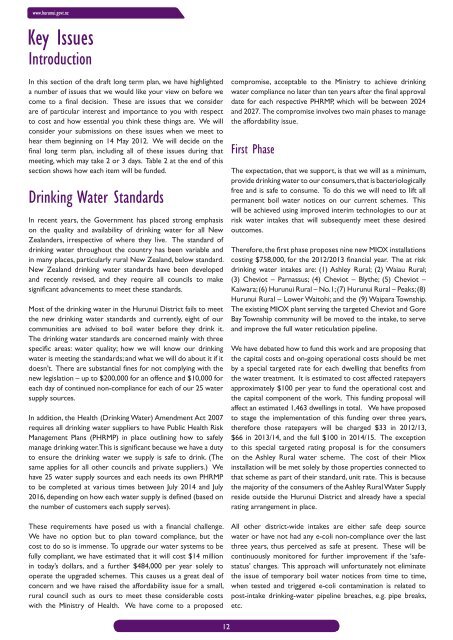DRAFT LTP book.indb - Hurunui District Council
DRAFT LTP book.indb - Hurunui District Council
DRAFT LTP book.indb - Hurunui District Council
Create successful ePaper yourself
Turn your PDF publications into a flip-book with our unique Google optimized e-Paper software.
www.hurunui.govt.nzKey IssuesIntroductionIn this section of the draft long term plan, we have highlighteda number of issues that we would like your view on before wecome to a fi nal decision. These are issues that we considerare of particular interest and importance to you with respectto cost and how essential you think these things are. We willconsider your submissions on these issues when we meet tohear them beginning on 14 May 2012. We will decide on thefi nal long term plan, including all of these issues during thatmeeting, which may take 2 or 3 days. Table 2 at the end of thissection shows how each item will be funded.Drinking Water StandardsIn recent years, the Government has placed strong emphasison the quality and availability of drinking water for all NewZealanders, irrespective of where they live. The standard ofdrinking water throughout the country has been variable andin many places, particularly rural New Zealand, below standard.New Zealand drinking water standards have been developedand recently revised, and they require all councils to makesignifi cant advancements to meet these standards.Most of the drinking water in the <strong>Hurunui</strong> <strong>District</strong> fails to meetthe new drinking water standards and currently, eight of ourcommunities are advised to boil water before they drink it.The drinking water standards are concerned mainly with threespecifi c areas: water quality; how we will know our drinkingwater is meeting the standards; and what we will do about it if itdoesn’t. There are substantial fi nes for not complying with thenew legislation – up to $200,000 for an offence and $10,000 foreach day of continued non-compliance for each of our 25 watersupply sources.In addition, the Health (Drinking Water) Amendment Act 2007requires all drinking water suppliers to have Public Health RiskManagement Plans (PHRMP) in place outlining how to safelymanage drinking water. This is signifi cant because we have a dutyto ensure the drinking water we supply is safe to drink. (Thesame applies for all other councils and private suppliers.) Wehave 25 water supply sources and each needs its own PHRMPto be completed at various times between July 2014 and July2016, depending on how each water supply is defi ned (based onthe number of customers each supply serves).These requirements have posed us with a fi nancial challenge.We have no option but to plan toward compliance, but thecost to do so is immense. To upgrade our water systems to befully compliant, we have estimated that it will cost $14 millionin today’s dollars, and a further $484,000 per year solely tooperate the upgraded schemes. This causes us a great deal ofconcern and we have raised the affordability issue for a small,rural council such as ours to meet these considerable costswith the Ministry of Health. We have come to a proposedcompromise, acceptable to the Ministry to achieve drinkingwater compliance no later than ten years after the fi nal approvaldate for each respective PHRMP, which will be between 2024and 2027. The compromise involves two main phases to managethe affordability issue.First PhaseThe expectation, that we support, is that we will as a minimum,provide drinking water to our consumers, that is bacteriologicallyfree and is safe to consume. To do this we will need to lift allpermanent boil water notices on our current schemes. Thiswill be achieved using improved interim technologies to our atrisk water intakes that will subsequently meet these desiredoutcomes.Therefore, the fi rst phase proposes nine new MIOX installationscosting $758,000, for the 2012/2013 fi nancial year. The at riskdrinking water intakes are: (1) Ashley Rural; (2) Waiau Rural;(3) Cheviot – Parnassus; (4) Cheviot – Blythe; (5) Cheviot –Kaiwara; (6) <strong>Hurunui</strong> Rural – No.1; (7) <strong>Hurunui</strong> Rural – Peaks; (8)<strong>Hurunui</strong> Rural – Lower Waitohi; and the (9) Waipara Township.The existing MIOX plant serving the targeted Cheviot and GoreBay Township community will be moved to the intake, to serveand improve the full water reticulation pipeline.We have debated how to fund this work and are proposing thatthe capital costs and on-going operational costs should be metby a special targeted rate for each dwelling that benefi ts fromthe water treatment. It is estimated to cost affected ratepayersapproximately $100 per year to fund the operational cost andthe capital component of the work. This funding proposal willaffect an estimated 1,463 dwellings in total. We have proposedto stage the implementation of this funding over three years,therefore those ratepayers will be charged $33 in 2012/13,$66 in 2013/14, and the full $100 in 2014/15. The exceptionto this special targeted rating proposal is for the consumerson the Ashley Rural water scheme. The cost of their Mioxinstallation will be met solely by those properties connected tothat scheme as part of their standard, unit rate. This is becausethe majority of the consumers of the Ashley Rural Water Supplyreside outside the <strong>Hurunui</strong> <strong>District</strong> and already have a specialrating arrangement in place.All other district-wide intakes are either safe deep sourcewater or have not had any e-coli non-compliance over the lastthree years, thus perceived as safe at present. These will becontinuously monitored for further improvement if the ‘safestatus’changes. This approach will unfortunately not eliminatethe issue of temporary boil water notices from time to time,when tested and triggered e-coli contamination is related topost-intake drinking-water pipeline breaches, e.g. pipe breaks,etc.12
















